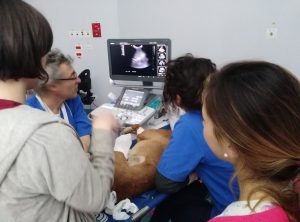Hematologic abnormalities and flow cytometric immunophenotyping results in dogs with hematopoietic neoplasia: 210 cases (2002-2006)
Tasca S, Carli E, Caldin M, Menegazzo L, Furlanello T, Gallego LS.
Hematologic abnormalities and flow cytometric immunophenotyping results in dogs with hematopoietic neoplasia: 210 cases (2002-2006)
Vet Clin Pathol. 2009 Mar;38(1):2-12. doi: 10.1111/j.1939-165X.2008.00099.x.
Abstract
BACKGROUND: Growing interest in veterinary oncohematology has facilitated the recent development and advancement of new techniques, such as flow cytometry, for immunophenotyping hematopoietic neoplasia in animals.
OBJECTIVE: The aim of this retrospective study was to characterize hematologic abnormalities and flow cytometric immunophenotyping (FCI) results in cases of hematopoietic neoplasia in dogs.
METHODS: Signalment, CBC data, and FCI results were obtained for 210 dogs with blood samples submitted to our laboratory. Immunophenotyping was carried out using an Epics XL-MCL flow cytometer and a panel of 10 antibodies (CD45, CD3, CD4, CD8, CD79, CD21, CD14, CD34, CD41/61, CD61). The prevalence and severity of hematologic abnormalities was determined for the different types of hematopoietic neoplasms.
RESULTS: Based on cell morphology and phenotype, cases were classified as: acute lymphoblastic leukemia (ALL, n=51), acute myeloid leukemia (AML, n=33), chronic lymphocytic leukemia (CLL, n=61), and leukemic high-grade lymphoma (L-HGL, n=65). Most cases of ALL (47/51) and L-HGL (41/65) had a B-cell phenotype, while most cases of CLL (54/61) had a T-cell phenotype, with a high prevalence of the large granular lymphocyte subtype (49/61). Anemia was found in 85% of all cases and was significantly more severe in ALL and AML compared with CLL and L-HGL. Neutropenia was seen in 64-78% of acute leukemias (AML and ALL) in contrast to no cases of CLL and 11% of L-HGL. Thrombocytopenia was seen in 88-90% of acute leukemias in contrast to 15% of CLL and 40% of L-HGL. Thrombocytopenia was more prevalent (71% vs 22%) and significantly more severe in T-cell vs B-cell L-HGL.
CONCLUSION: A standard CBC is useful in suggesting the type of hemoproliferative disorder and may also help to predict the phenotype, especially in cases of L-HGL.






 Il Direttore Sanitario Dott. Marco Caldin
Il Direttore Sanitario Dott. Marco Caldin